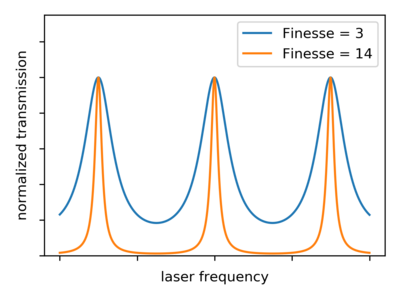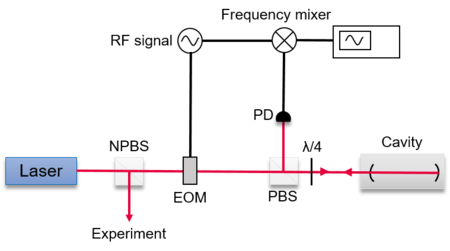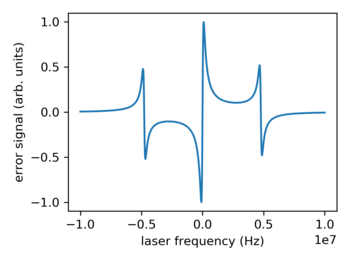Locking to a Reference Resonator
While the width of the spectral feature in atomic spectroscopy is ultimately limited by the natural linewidth of the specific transition, the spectral feature of a Fabry-Pérot cavity is given by the reflectivity of its mirrors and the distance between them. Cavity linewidths of several kHz can be reached. This makes error signals with a very steep slope and therefore with a very good signal-to-noise ratio possible.
The spectral feature can be obtained from the light either transmitted through or reflected from the cavity. A typical cavity transmission is shown in Figure 11.

The most straightforward way to generate an error signal is to send part of the laser light through the cavity and measure the transmission with a photodiode behind the cavity. Analogous to the techniques described before, side-of-fringe and top-of-fringe locking can be realized using this transmission signal. However, fast fluctuations of the laser phase or frequency are spectrally represented by frequency components with a large deviation from the laser´s central frequency. If this deviation is larger than the cavity linewidth, then these components will be suppressed in the cavity transmission, i.e. the cavity acts as a low pass filter for phase and frequency noise. Therefore a lock built upon an error signal obtained from the cavity transmission will have low performance suppressing noise components at frequencies larger than the cavity linewidth. We therefore focus on schemes that use the reflection of the cavity.
The implementation of side-of-fringe locking using the cavity reflection is straightforward, but has the disadvantages described above. Instead, we will focus on a scheme known as the Pound-Drever-Hall (PDH) technique. It is based on FM spectroscopy and uses the reflection of a cavity. The optical setup used for the generation of the PDH error signal is shown in Figure 12. Part of the laser light, which is separated from the main beam using a non-polarizing beam splitter (NPBS), is sent through an EOM which modulates the phase of the field with a modulation frequency Ω typically much larger than the cavity linewidth. This modulation leads to frequency sidebands separated by Ω from the central frequency (carrier). The reflected light is separated from the incident light using the combination of a polarizing beam splitter (PBS) and a λ/4 waveplate. Because the frequency sidebands are off-resonant, they will be reflected from the first cavity mirror without acquiring a phase shift, while the carrier enters the cavity and obtains a phase shift that depends on the deviation of the laser frequency from the cavity resonance. The superposition of both components creates a beat signal which oscillates with frequency Ω and whose phase depends on the frequency of the laser. Subsequently, this signal is recorded with a photodiode. By mixing the signal from the photodiode with a reference RF signal with the same frequency Ω, a DC signal which is proportional to the phase of the PD signal, and thus depends on the frequency of the laser light, is obtained. It is important to adjust the phase between the reference signal and the PD signal to obtain the maximum amplitude of the mixed signal. The signal obtained from this procedure is depicted in Figure 13. It has a zero crossing on resonance and thus serves as an error signal for top-of-fringe locking. The steepness of the slope around resonance is inversely proportional to the cavity linewidth, i.e. a small cavity linewidth yields large signal-to-noise ratio. A more detailed introduction to the PDH method can be found in the great article by Eric D. Black. As the PDH error signal is a function of the frequency deviation, locks based on it are frequency locks.


TOPTICA Solution
With the PDH/DLC pro, TOPTICA offers a module for the electronic generation of a PDH signal. This includes an RF signal e.g. for driving the EOM. The PD signal recording the reflection of the cavity is fed into the input of the PDH/DLC pro module. Parameters like phase shift and gains can comfortably be adjusted using the DLC pro interface. As PID controllers, both the DLC pro Lock as well as external controllers like the FALC pro can be employed. While the DLC pro Lock is typically used to transfer the long-term stability of e.g. a ULE cavity to the laser, the FALC pro can actually be used to dramatically decrease the laser linewidth. A similar setup based on TOPTICA lasers and locking electronics was used to realize linewidths of below 1 Hz. It is recommended to extend the DLC pro Lock with the PDH/DLC pro if it is important to avoid modulation sidebands in the kHz range.
